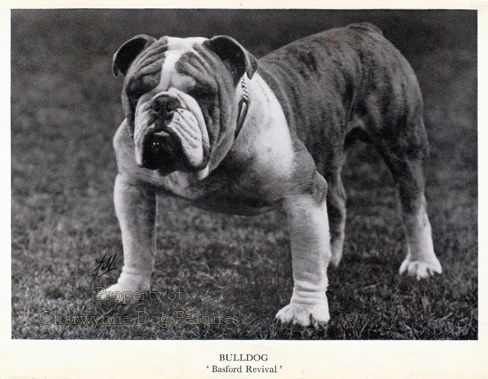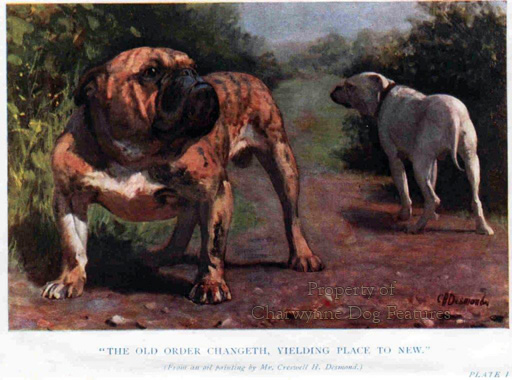324 Working Bulldog
RESURRECTING THE WORKING BULLDOG
by David Hancock
 In his "An Introduction to the Field Sports of France" of 1846, O'Connor wrote: "Those who hunt the vieux solitaire (i.e. an old boar, living alone) in a less formal manner, and with a less expensive equipage, employ a few couple of the strongest dogs they can procure: (bull dogs are much esteemed for the purpose), and search for him where they conceive they are most likely to find him in the forest..." Wild boar are fearsome adversaries; most hounds will not close with them, hence the use of recklessly brave 'seizers' or bulldogs. It could well be that more bulldogs died in the boar hunt than boars.
In his "An Introduction to the Field Sports of France" of 1846, O'Connor wrote: "Those who hunt the vieux solitaire (i.e. an old boar, living alone) in a less formal manner, and with a less expensive equipage, employ a few couple of the strongest dogs they can procure: (bull dogs are much esteemed for the purpose), and search for him where they conceive they are most likely to find him in the forest..." Wild boar are fearsome adversaries; most hounds will not close with them, hence the use of recklessly brave 'seizers' or bulldogs. It could well be that more bulldogs died in the boar hunt than boars.
Charles St John, in his "Wild Sports and Natural History of the Highlands" of 1919, wrote that: "I at one time had an English bulldog, who accompanied me constantly in deer stalking; he learned to crouch and creep up to the deer with me, never showing himself, and seemingly to understand perfectly what I wished him to do. When necessary I could leave him for hours together, lying alone on the hill, when he would never stir till called by me." Here is a skilful dog displaying composure, patience and discipline, backed by stamina. This is the performance of a sporting breed. Such qualities were valued by those operating in testing circumstances overseas, forestry officials in India and pioneer farmers in South Africa, for example.
Sanderson, in his book "Elephant Catching in India", towards the end of the 19th century, described the dogs used to protect forestry workers from bears, buffalo and boar; all were Bulldog-based. He used what he called a Bullmastiff, weighing 40lbs, a Bull Terrier bitch, weighing 35lbs, a Bull Terrier dog, weighing 40lbs and two pups from a mating of the first two. He wrote that local dogs would bay big animals which menaced his workers but only the "bullbreeds" would stand their ground and defend the workers, regularly risking their lives in doing so. The bravery of a dog weighing only three stones in facing such huge opponents is quite astonishing.
Bulldog blood has long been valued for instilling bravery and fortitude into other breeds. Sam Wickens, writing as Philo-Kuon, in the celebrated breed standard of 1865, stated that: "He is generally an excellent guard, an extraordinary water dog, and very valuable to cross with Terriers, Pointers, Hounds, Greyhounds, etc., to give them courage and endurance." In his "The Dog" of 1880, the Rev Thomas Pearce, writing as Idstone, said that: "The Bulldog owes his celebrity to his indomitable courage, which he transmits in large measure to his descendants when crossed with almost any breed." So the Bulldog is renowned for improving other sporting breeds, but isn't allowed to be considered one itself!
Dogs with courage and tenacity were greatly valued by pioneer farmers in 19th century South Africa. A writer in "The South African Kennel Gazette" of March 1909 recorded: "...I had two dogs, the one named Kafir whose sire was a cross between a bull and a mastiff, dam a foxhound." Another writer in the same issue, described how in 1857 he had defended his stock using "...a cross breed between the mastiff and the bulldog, the parents coming from Europe...The cross breed, that is the mastiff and the bulldog, combine the swiftness and tenacity of the one with the strength of the other..." Bullmastiff fanciers will like that. But it is interesting that the Bulldog's swiftness was admired. 
Bulldogs had to be swift, agile and athletic just to survive in the appalling world of baiting animals. The disgraceful treatment meted out to the baited animals gives you some idea of the so-called human beings involved in such barbarity. There are records of bears having their claws and teeth ripped out, bulls having hot oil poured in their ears, black pepper being thrust up their nostrils, having not just their tongues and noses cut out but their forelegs cut off to lower their height. Most of the baiting dogs suffered too.
Some commentators, especially around Crufts time, suggest that the design of the Bulldog of today inflicts discomfort and disadvantage on the breed amounting to cruelty. Simon Wolfensohn, a practising vet, writing in the New Scientist nineteen years ago, listed, in the breed of Bulldog: respiratory problems due to the short nose, dental problems due to the short jaw, protusion of the upper or lower jaw, skin infections due to bacteria becoming trapped in the folds of the skin and problems giving birth. The authoritative "Medical and Genetic Aspects of Purebred Dogs" edited by Clark and Stainer, published by Forum Publications USA in 1994, states that only 6% of bitches whelp naturally, that of 707 pups delivered in 150 caesarean sections 37 had cleft palates and 58 of them died of walrus syndrome (three times normal birth weight).
The book describes as "one of the most devastating conditions found in the Bulldog" foreleg lameness caused by loose shoulder joints and leading to severe chronic strain on the shoulder and elbow joints, resulting in debilitating foreleg arthritis. Since the breed standard requires the Bulldog to have forelegs set wide apart and elbows which stand well away from the ribs, such a problem is scarcely surprising. As this breed standard demands a dog with a massive head and hindquarters lighter in comparison with heavy foreparts, natural whelping is hardly assisted.
In his "The Bulldog-A Monograph" of 1899, Edgar Farman wrote: "The early show Bulldogs were not so cloddy as the exaggerated specimens now are, they were not so heavily built that their powers of locomotion were impeded..." The "powers of locomotion" of the Bulldog are not exactly helped by the wording on gait/movement in the breed standard: peculiarly heavy and constrained. Why would anyone want their dog to walk in a strangely cumbersome and unnaturally forced manner? Or is this inevitable when the standard demands forelegs wide apart, elbows which stand well away from the dog's ribs and hocks "made to approach each other", with stifles "round" (if that is physically possible).
The biggest handicap to the modern non-sporting Bulldog is not so much in its unnatural movement but in its untypically short muzzle. It is significant that in those bulldog breeds developed outside Britain from stock taken there several centuries ago do not feature a muzzleless head. The American Bulldog, the Alapaha Blue Blood Bulldog, the "Olde Englishe Bulldogges" of John and Lolly Wilkinson in Vancouver and the Ca de Bou or Majorcan Bulldog all have balanced heads with good muzzle length. These breeds resemble the sporting Bulldogs depicted in old prints much more than our contemporary British breed. And the reason is quite simple: they pre-date the introduction of Pug blood into the Bulldog.
Books on both the Pug and the Bulldog usually choose to overlook this fact, which is dishonest and misleading. Authorities such as Vero Shaw, Stonehenge, Sydenham Edwards, Rawdon Lee and Robert Leighton, each one respected as a dog historian, all testify that this cross took place. It brought to the Bulldog the "smashed face" of some Asiatic breeds and a feature not only untypical and harmful to health but one genetically important, for it is dominant. Its harm was summarised by vet Simon Wolfensohn in the New Scientist of 1981: "The shortening of the jaw and the anterior part of the skull in short-nosed breeds has the effect of distorting the airway; the soft palate is prolonged to the point that it interferes with breathing...and the nasal sinuses are shortened, giving rise to chronic sinusitis and more serious respiratory infections...most of these breeds (i.e. Pugs and Bulldogs) suffer dental problems because the upper and lower jaws are not equal in length and the jaw is so short that the teeth are overcrowded..."
The muzzleless Bulldog is handicapped and untypical. In his "The Dog Book" of 1906, James Watson recalls visiting a dog show at Alexandra Palace at the end of the 1870s and being briefed by the famous Bulldog man Bill George's son, Alfred, with the words: "...there has been a great change since you went away. You will see some of the old sort at father's, but they don't do for showing." The craving for shortened muzzles in show ring Bulldogs had won the day, sadly for the health and type of this superb breed.
Of all dog breeds the Bulldog can lay claim to be the one most abused by man. It is man who forced these dogs to torment bulls and bears in the name of a so-called sport. It is man who has bred these dogs so that they feature a long list of physical and health handicaps. Barbarity can take different forms and cruelty can be indirect. Surely in the allegedly more enlightened times of the more compassionate 21st century, we can restore this magnificent native breed to its real sporting type and authentic healthier design. There is a moral vacuum here, just waiting to be filled, not just by individuals like Ken Mollett, with his re-created Victorian Bulldogs, but by a concerned nation of animal lovers -- you and me! Don't buy deformed dogs!